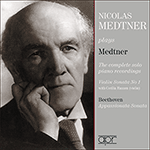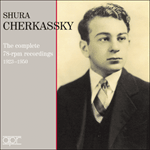
Welcome to Hyperion Records, a British classical label devoted to presenting high-quality recordings of music of all styles and from all periods from the twelfth century to the twenty-first.
Hyperion offers both CDs, and downloads in a number of formats. The site is also available in several languages.
Please use the dropdown buttons to set your preferred options, or use the checkbox to accept the defaults.

To Op 34 No 1 he gave the title The Magic Violin. Although unattributed in the score, it seems likely that this comes from a poem of the same name by Nikolai Gumilev (1886–1921) in which the poet implores a child not to succumb to the seductive violin which will unleash all kinds of horrors upon him through its magic. Certainly, the sinuous lines of the recurring waltz-theme and the increasingly violent interludes seem in tune with this supposition. Although Medtner described Op 34 No 2 to friends as ‘a tale told by a river bank’ (easily discernible in the rippling currents of the left hand), by quoting from Tyutchev’s mystical poem Peace (‘… what we once called ours is gone for ever’), he suggests deeper thoughts about the ephemerality of existence, no less. Above Op 34 No 3, Medtner simply wrote ‘Wood spirit (but a kind, plaintive one)’. According to his Canadian pupil and disciple Bernard Pinsonneault he amplified this, saying with a smile: ‘He’s a highly capricious sorcerer who does a thousand magic tricks, conjures up all kind of strange creatures and launches multicoloured arabesques from his fingers; he’s a grimacing sorcerer but … he is never wicked.’ His grimaces reveal that the gulf between Medtner and Prokofiev was not as wide as either of them imagined. Op 34 No 4 bears a quotation from Pushkin: ‘… there lived once a poor knight’. Pushkin’s poem has a special resonance in the Russian psyche. Friends relate that Dostoyevsky had tears in his eyes when reading it to his children and it has been often cited as the inspiration for Prince Mishka in his novel The Idiot. Jungians interpret the character as a prototype of the creative artist, others as anti-hero. The poem tells of a knight in Palestine who worships the Virgin Mary, renouncing not only all other women but also the Holy Trinity. When, on his deathbed many years later, he is about to be dragged to hell by demons for this blasphemy, the Blessed Virgin herself intervenes and bears him aloft. The music is of an extraordinarily exalted piety and, at the moment of his transfiguration, truly inspirational, as its sombre strains transmute into a radiant D major melange of prayers, bells and angel trumpets. At this point Medtner confessed to being inspired by the sublime transition from the desolation of the Largo e mesto in Beethoven’s Piano Sonata Op 10 No 3 to the sunlit D major of the succeeding Menuetto.
from notes by Hamish Milne © 2007
L’op. 34 no 1 s’intitule Le Violon magique. Quoique le partition ne le précise pas, ce titre semble provenir d’un poème, pareillement libellé, de Nikolaï Gumilev (1886– 1921): le poète y implore un enfant de ne pas succomber au séduisant violon, dont la magie, sinon, libérera sur lui toutes sortes d’horreurs—une supposition que semblent corroborer les lignes sinueuses du récurrent thème de valse et les interludes de plus en plus violents. À des amis, Medtner décrivit l’op. 34 no 2 comme un «conte raconté par une berge» (ce qu’attestent les courants ondoyants de la main gauche)—il citait alors Paix, le poème mystique de Tioutchev («… ce que nous disions jadis nôtre s’en est allé pour toujours»)—, mais ce qui transparaît ici, c’est une réflexion plus profonde sur le caractère éphémère de l’existence, rien de moins. Au-dessus de l’op. 34 no 3, Medtner précisa juste «sylvain (mais un sylvain gentil, plaintif)». Une indication que, selon son élève et disciple canadien Bernard Pinsonneault, il développait dans un sourire: «C’est un sorcier extrêmement fantasque, qui fait mille tours de magie, invoque toutes sortes de créatures étranges et lance, de ses doigts, des arabesques multicolores; c’est un sorcier grimaçant … mais il n’est jamais méchant.» Ses grimaces révèlent que l’abîme entre Medtner et Prokofiev n’était pas aussi profond que tous deux le croyaient. L’op. 34 no 4 porte une citation de Pouchkine: «… là vivait jadis un pauvre chevalier». Ce poème a une résonance particulière dans la psyché russe et, selon ses amis, Dostoïevski avait les larmes aux yeux quand il le lisait à ses enfants—on dit même souvent qu’il lui aurait inspiré le personnage du prince Mychkine, dans L’Idiot. Les jungiens y voient le prototype de l’artiste créatif, les autres un antihéros. Le poème parle d’un chevalier en Palestine qui adore la Vierge Marie au point de renoncer à toute autre femme, mais aussi à la sainte Trinité. Lorsque, bien des années plus tard, sur son lit de mort, des démons s’apprêtent à l’entraîner en enfer pour ce blasphème, la sainte Vierge intervient en personne et le porte dans les airs. La musique est d’une piété extraordinairement exaltée et devient véritablement inspirée au moment de la transfiguration du héros, quand ses sombres accents se transmuent en un radieux mélange (en ré majeur) de prières, de cloches et de trompettes angéliques. Medtner reconnut avoir été influencé par la sublime transition entre la désolation du Largo e mesto de la Sonate pour piano op. 10 no 3 de Beethoven et le lumineux ré majeur du Menuetto suivant.
extrait des notes rédigées par Hamish Milne © 2007
Français: Hypérion
Dem op. 34, Nr. 1 gab er den Titel Die Zaubergeige. Obwohl nicht in der Partitur angegeben, stammt er höchst wahrscheinlich aus dem gleichnamigen Gedicht von Nikolai Gumilew (1886–1921), in dem der Dichter ein Kind anfleht, der verführerischen Violine nicht nachzugeben, die ihm allerlei Gräuel bereiten wird, wenn es seinem Zauber unterliegt. Die schlängelnden Linien des wiederkehrenden Walzerthemas und die nach und nach heftigeren Zwischenspiele scheinen mit dieser Vermutung im Einklang. Obwohl Medtner op. 34, Nr. 2, seinen Freunden als „eine Geschichte, die am Flussufer erzählt wird“, beschreibt (in den plätschernden Strömen der linken Hand leicht zu erkennen), deutet er mit seinem Zitat aus Tjutschews mystischer Dichtung Frieden („… was wir einst als unser bezeichneten, ist auf ewig verschwunden“) deutet er tiefere Gedanken über nichts Geringeres als die Vergänglichkeit der Existenz an. Op. 34, Nr. 3 überschrieb Medtner schlicht mit „Waldgeist (aber ein milder, trauriger)“. Laut seines kanadischen Schülers und Verfechters Bernard Pinsonneault erweiterte er dies lächelnd: „Er ist ein äußerst launischer Zauberer, der tausend Zaubertricks anstellt, allerlei magische Kreaturen heraufbeschwört und bunte Arabesken aus seinen Fingern hervorzaubert; er ist ein grinsender Grimassen schneidender Zauberer … aber nie böse.“ Seine Grimassen enthüllen, dass die Kluft zwischen Medtner und Prokofjew nie so weit war, wie beide sich vorstellten. Op. 34, Nr. 4 trägt ein Zitat aus Puschkin: „… es war einmal ein armer Ritter“. Puschkins Gedicht resoniert besonders in der russischen Psyche. Freunde erzählen, dass Dostojewski Tränen in den Augen hatte, wenn er es seinen Kindern vorlas, und es wurde oft als Inspiration für Prinz Mischka in seinem Roman Der Idiot angegeben. Jungianer interpretieren den Charakter als Prototyp des schöpferischen Künstlers, andere als Antihelden. Das Gedicht erzählt von einem Ritter in Palästina, der die Jungfrau Maria anbetet, und nicht nur allen anderen Frauen abschwört sondern auch der Heiligen Dreieinigkeit. Viele Jahre später, auf seinem Totenbett, als er wegen dieser Blasphemie von Dämonen in die Hölle gezerrt werden soll, greift die Gebenedeite Jungrau selbst ein und trägt ihn selbst empor. Die Musik besitzt eine außerordentlich erhabene Frömmigkeit und ist im Augenblick seiner Verklärung wahrhaft inspiriert, als sich ihre feierlich-düsteren Töne in eine leuchtende D-Dur-Mischung von Gebet, Glocken und trompetenden Engeln verwandeln. Medtner gestand ein, dass er hier durch die sublime Verwandlung von der öden Verzweiflung des Largo e mesto zum sonnenlichten D-Dur des folgenden Menuetto in Beethovens Klaviersonate op. 10, Nr. 3 inspiriert wurde.
aus dem Begleittext von Hamish Milne © 2007
Deutsch: Renate Wendel
 Medtner: The complete solo piano recordings Medtner: The complete solo piano recordingsAPR’s landmark issue on three CDs of Nicolas Medtner’s complete solo recordings, which included fifteen 78-rpm sides of previously thought lost Columbia recordings from 1931 and an unpublished HMV recording of his Violin Sonata No 1, are here reis ...» More |
 Shura Cherkassky - The complete 78-rpm recordings, 1923-1950 Shura Cherkassky - The complete 78-rpm recordings, 1923-1950In his later years, Shura Cherkassky (1909-1995) was regarded as one of the last ‘Romantics’—a throwback to the so-called ‘golden age’ of pianism in the first decades of the 20th century. As a pupil of Josef Hofmann, he had an impeccable pedigree, ...» More |

